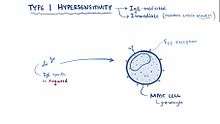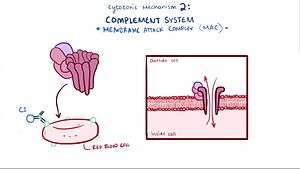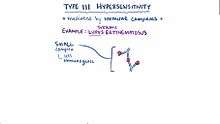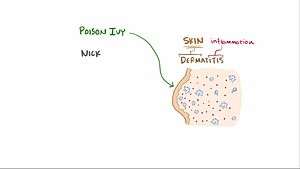Hypersensitivity
| Hypersensitivity | |
|---|---|
| Classification and external resources | |
| Specialty | Allergy and immunology |
| ICD-10 | T78.4 |
| ICD-9-CM | 995.3 |
| DiseasesDB | 28827 |
| MeSH | D006967 |
Hypersensitivity (also called hypersensitivity reaction or intolerance) is a set of undesirable reactions produced by the normal immune system, including allergies and autoimmunity. They are usually referred to as an over- reaction of the immune system and these reactions may be damaging, uncomfortable, or occasionally fatal. Hypersensitivity reactions require a pre-sensitized (immune) state of the host. They are classified in four groups after the proposal of P. G. H. Gell and Robin Coombs in 1963.[1]
Coombs and Gell classification
| Type | Alternative names | Often mentioned disorders | Mediators | Description | Video explanation |
|---|---|---|---|---|---|
| I | Allergy (immediate) | Fast response which occurs in minutes, rather than multiple hours or days. Free antigens cross link the IgE on mast cells and basophils which causes a release of vasoactive biomolecules. Testing can be done via skin test for specific IgE.[2] |  Video explanation of type I hypersensitivity | ||
| II | Cytotoxic, antibody-dependent |
|
|
Antibody (IgM or IgG) binds to antigen on a target cell, which is actually a host cell that is perceived by the immune system as foreign, leading to cellular destruction via the MAC. Testing includes both the direct and indirect Coombs test.[3] |  Video explanation of type II hypersensitivity |
| III | Immune complex disease |
|
Antibody (IgG) binds to soluble antigen, forming a circulating immune complex. This is often deposited in the vessel walls of the joints and kidney, initiating a local inflammatory reaction.[4] |  Video explanation of type III hypersensitivity | |
| IV | Delayed-type hypersensitivity,[2][3] cell-mediated immune memory response, antibody-independent |
|
Helper T cells (specifically Th1 helper t cells) are activated by an antigen presenting cell. When the antigen is presented again in the future, the memory Th1 cells will activate macrophages and cause an inflammatory response. This ultimately can lead to tissue damage.[6] |  Video explanation of type IV hypersensitivity | |
| V | Autoimmune disease, receptor mediated (see below) |
|
Type V
This is an additional type that is sometimes (often in the UK) used as a distinction from Type 2.[7]
Instead of binding to cell surfaces, the antibodies recognise and bind to the cell surface receptors, which either prevents the intended ligand binding with the receptor or mimics the effects of the ligand, thus impairing cell signaling.
Some clinical examples:
The use of Type 5 is rare. These conditions are more frequently classified as Type 2, though sometimes they are specifically segregated into their own subcategory of Type 2.
See also
- Type I hypersensitivity
- Type II hypersensitivity
- Type III hypersensitivity
- Type IV hypersensitivity
- Type V hypersensitivity
- Intolerance
References
- ↑ Gell PGH, Coombs RRA, eds. Clinical Aspects of Immunology. 1st ed. Oxford, England: Blackwell; 1963. Section IV, Chapter 1
- 1 2 Black, C. A. (1999). "Delayed type hypersensitivity: Current theories with an historic perspective". Dermatology Online Journal. 5 (1): 7. PMID 10673450.
- 1 2 Delayed Hypersensitivity Reactions at eMedicine
- ↑ Kumar, Vinay; Abbas, Abul K.; Aster, Jon C., eds. (2014). "Hypersensitivity: Immunologicaly Mediated Tissue Injury". Robbins & Cotran Pathologic Basis of Disease (9th ed.). Elsevier Health Sciences. pp. 200–11. ISBN 978-0-323-29635-9.
- ↑ Mitchell, Richard Sheppard; Kumar, Vinay; Abbas, Abul K.; Fausto, Nelson (2007). "Table 5-1". Robbins Basic Pathology (8th ed.). Philadelphia: Saunders. ISBN 1-4160-2973-7.
- ↑ Le, Tau. First Aid for the USMLE Step 1 2013, p. 203-204
- ↑ Rajan, T.V. (2003). "The Gell–Coombs classification of hypersensitivity reactions: A re-interpretation". Trends in Immunology. 24 (7): 376–9. doi:10.1016/S1471-4906(03)00142-X. PMID 12860528.